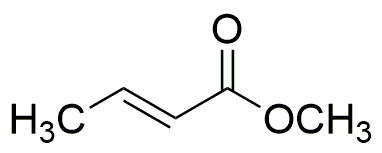Methyl crotonate is widely utilized in research focused on:
- Flavor and Fragrance Industry: This compound is used as a flavoring agent due to its pleasant fruity aroma, making it popular in food and cosmetic products.
- Synthesis of Polymers: Methyl crotonate serves as a monomer in the production of various polymers, enhancing properties like flexibility and durability in materials used in packaging and coatings.
- Pharmaceutical Applications: It is involved in the synthesis of pharmaceutical intermediates, contributing to the development of new drugs and therapeutic agents.
- Organic Synthesis: Researchers utilize methyl crotonate in organic reactions, such as Michael additions and Diels-Alder reactions, to create complex molecules efficiently.
- Research in Green Chemistry: Its role in sustainable chemical processes is being explored, as it can be derived from renewable resources, aligning with eco-friendly practices in the chemical industry.
General Information
Properties
Safety and Regulations
Applications
Methyl crotonate is widely utilized in research focused on:
- Flavor and Fragrance Industry: This compound is used as a flavoring agent due to its pleasant fruity aroma, making it popular in food and cosmetic products.
- Synthesis of Polymers: Methyl crotonate serves as a monomer in the production of various polymers, enhancing properties like flexibility and durability in materials used in packaging and coatings.
- Pharmaceutical Applications: It is involved in the synthesis of pharmaceutical intermediates, contributing to the development of new drugs and therapeutic agents.
- Organic Synthesis: Researchers utilize methyl crotonate in organic reactions, such as Michael additions and Diels-Alder reactions, to create complex molecules efficiently.
- Research in Green Chemistry: Its role in sustainable chemical processes is being explored, as it can be derived from renewable resources, aligning with eco-friendly practices in the chemical industry.
Documents
Safety Data Sheets (SDS)
The SDS provides comprehensive safety information on handling, storage, and disposal of the product.
Product Specification (PS)
The PS provides a comprehensive breakdown of the product’s properties, including chemical composition, physical state, purity, and storage requirements. It also details acceptable quality ranges and the product's intended applications.
Certificates of Analysis (COA)
Search for Certificates of Analysis (COA) by entering the products Lot Number. Lot and Batch Numbers can be found on a product’s label following the words ‘Lot’ or ‘Batch’.
Numéro de catalogue
Numéro de lot/série
Certificates Of Origin (COO)
This COO confirms the country where the product was manufactured, and also details the materials and components used in it and whether it is derived from natural, synthetic, or other specific sources. This certificate may be required for customs, trade, and regulatory compliance.
Numéro de catalogue
Numéro de lot/série
Safety Data Sheets (SDS)
The SDS provides comprehensive safety information on handling, storage, and disposal of the product.
DownloadProduct Specification (PS)
The PS provides a comprehensive breakdown of the product’s properties, including chemical composition, physical state, purity, and storage requirements. It also details acceptable quality ranges and the product's intended applications.
DownloadCertificates of Analysis (COA)
Search for Certificates of Analysis (COA) by entering the products Lot Number. Lot and Batch Numbers can be found on a product’s label following the words ‘Lot’ or ‘Batch’.
Numéro de catalogue
Numéro de lot/série
Certificates Of Origin (COO)
This COO confirms the country where the product was manufactured, and also details the materials and components used in it and whether it is derived from natural, synthetic, or other specific sources. This certificate may be required for customs, trade, and regulatory compliance.

